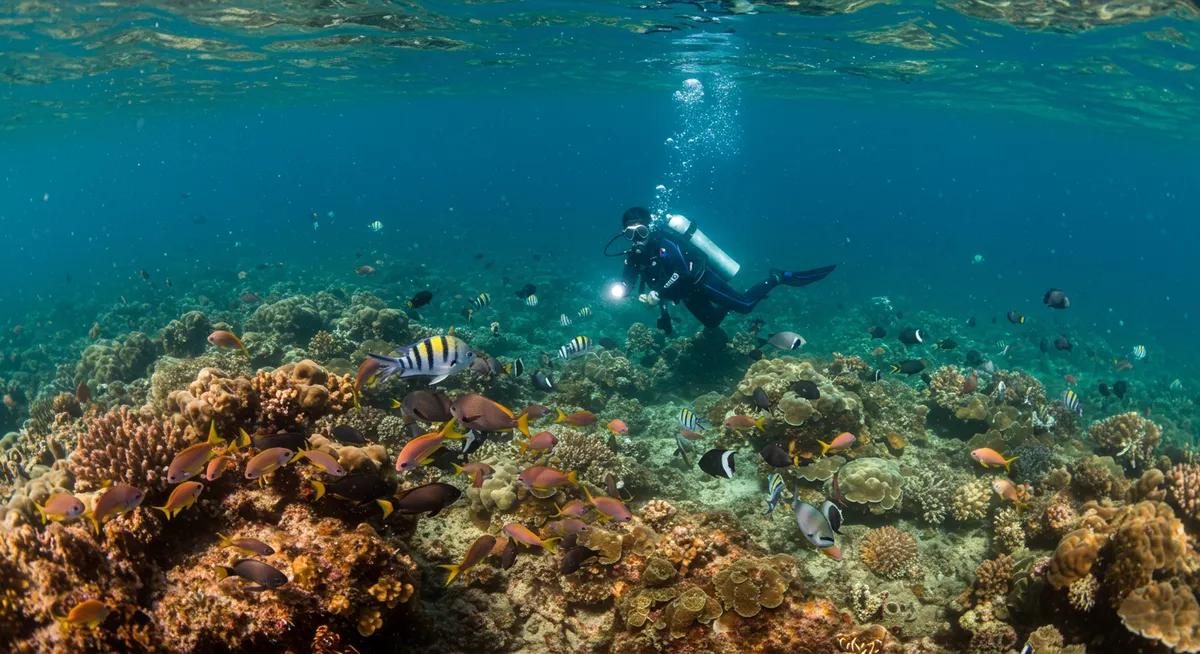
Diving Padangbai: Marine Life & Dive Spots Guide
Table of Contents
Want to find the best nature experiences for this destination? Chat with our nature tourism specialist!
Get Nature TipsCategory: diving-in-padangbai-marine-life-guide
Diving Padangbai: Your Marine Life & Dive Spots Guide
Having personally explored Bali's underwater wonders for over a decade, I can attest that Padangbai is a truly exceptional dive destination. This charming coastal village, often a transit point, hides a vibrant secret beneath its calm waters: an incredibly diverse ecosystem perfect for diving in Padangbai marine life guide. From novice snorkelers to advanced divers, its sites offer something for everyone. This comprehensive guide will illuminate the captivating underwater world awaiting you, detailing the best sites and the fascinating creatures you're likely to encounter, reinforcing why Padangbai remains a gem for underwater exploration on the Island of the Gods.
Top Dive Sites in Padangbai
Padangbai boasts an impressive array of dive sites, each offering unique underwater landscapes and marine encounters. The iconic Blue Lagoon is a sheltered bay renowned for its vibrant soft corals and resident reef sharks; it's also a fantastic spot for night dives. Nearby, Jepun is famous for its artificial reef and a small shipwreck, attracting abundant macro life like nudibranchs and frogfish. Furthermore, adventurers seek out the challenging conditions of Gili Mimpang and Tepekong, often referred to as the 'Shark Point,' where strong currents bring in pelagics. From my own dives, I've found Blue Lagoon to be consistently rewarding for vibrant reef photography, a true highlight for any underwater enthusiast. For a calmer experience, Bias Tugel Beach offers a surprisingly rich reef.
Encountering Padangbai's Rich Marine Life
The true allure of diving in Padangbai lies in its astonishing biodiversity. Divers here are frequently treated to sightings of white-tip reef sharks, majestic sea turtles, and impressive barracuda schools. For macro enthusiasts, Padangbai is a treasure trove; expect to discover an incredible variety of nudibranchs, colourful frogfish, and elusive pygmy seahorses tucked away in corals. Moreover, the coral gardens themselves are teeming with reef fish, from vibrant angelfish to curious clownfish. My experience repeatedly confirms that the sheer density of diverse species, especially during morning dives, makes Padangbai a top contender for marine life spotting in Bali. Observing a turtle gracefully gliding through the reef, for instance, is an unforgettable highlight of any Padangbai adventure.
Best Season & Conditions for Diving
To maximize your experience diving in Padangbai, understanding the seasonal conditions is key. Generally, the dry season from April to November offers the best visibility and calmest waters, making it ideal for exploring Padangbai's marine life. During these months, water temperatures typically hover around 26-29°C (79-84°F). Conversely, the wet season (December to March) can bring more rain and reduced visibility, though often fewer crowds. However, stronger currents, especially at sites like Gili Mimpang, can occur year-round, so always consult local dive guides. Personally, I find the shoulder months of April-May and October-November to be perfect, balancing excellent conditions with fewer divers at popular spots like those mentioned in our guide to Bali's best snorkeling spots.
Essential Tips for a Safe & Enjoyable Dive
Ensuring a safe and enjoyable dive experience in Padangbai requires some preparation. Always choose a reputable dive center with experienced local guides who know the specific currents and conditions of each site. They can provide invaluable insights into the best spots for spotting particular marine life and managing potential challenges. Secondly, practice good buoyancy control to protect the fragile coral reefs and conserve your air. Furthermore, staying hydrated and listening to your dive master's briefing are paramount. From my years of diving, I always recommend carrying a reef-safe sunscreen and a good quality underwater camera to capture the incredible sights. Remember, respecting the underwater environment is crucial for preserving the stunning Padangbai marine life for future generations of divers and explorers. These responsible practices enhance everyone's adventure.
Frequently Asked Questions
Is Padangbai suitable for beginner divers?
What marine animals can I expect to see in Padangbai?
What's the best time of year for diving in Padangbai?
In conclusion, diving in Padangbai offers an unparalleled opportunity to explore a rich and accessible underwater world. From the diverse dive sites like Blue Lagoon and Jepun to the astonishing array of marine life, including sharks, turtles, and macro wonders, Padangbai truly stands out. By preparing adequately and respecting the ocean, you're set for an unforgettable adventure. This guide to Padangbai's marine life should equip you with the knowledge to make the most of your trip. Don't miss the chance to plunge into these vibrant waters and discover Bali's hidden underwater paradise for yourself.